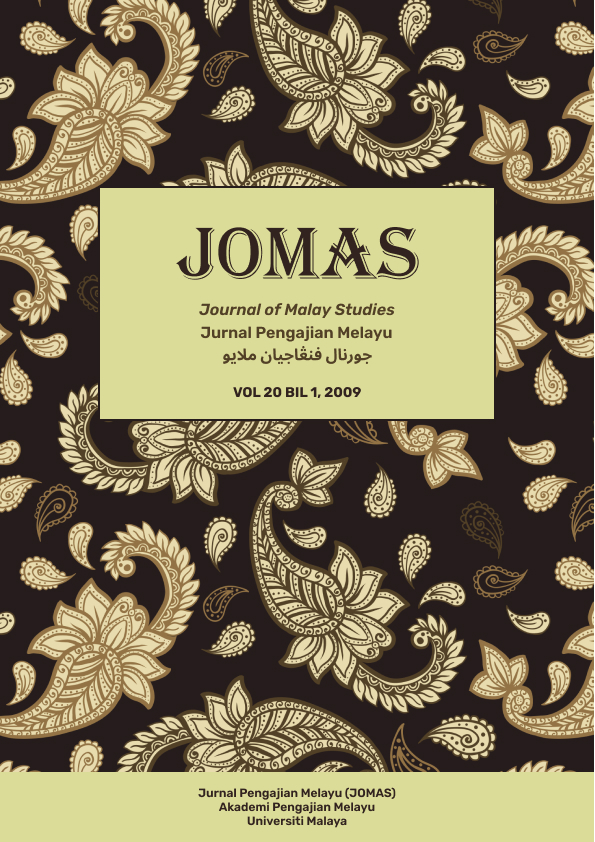THE EVOLUTION OF ISLAMIC-CULTURAL FUSION, IDENTITY, ISLAMIC RESURGENCE AND CURRENT CHALLENGES IN THE MALAY LIFE (EVOLUSI PENYATUAN KEBUDAYAAN /SLAM, /DENT/Tl, KEBANGKITAN /SLAM DAN CABARAN SEMASA DALAM KEHIDUPAN MELAYU
Main Article Content
Abstract
Di Malaysia banci penduduk terbaru menunjukkan bahawa umat Islam membentuk majoriti penduduknya iaitu 60%, pemeluk agama Buddha 19%, Kristian 9% Hindu 6.3%, Konfusis dan agama China tradisional yang lain 4.5%, manakala yang lain sama ada pengamal animisme atau tanpa agama. Dengan demikian Islam mewarnai secara definitif landskap budaya di Malaysia, manakala ciri-ciri agama dan budaya lain menambahkan keanekaannya. Bagi orang Melayu pemeluk agama Islam, keseluruhan aqidah, kepercayaan, amalan agama, nilai moral dan etika, ditunjangi oleh pengajaran Islam. Namun dalam beberapa amalan budayanya dapat dikesani ciri-ciri budaya indigenus dan Hindu antaranya amalan pengubatan dan penyembuhan tradisional, majlis pertabalan Sultan dan Yang Dipertuan Agong, dalam permainan wayang kulic, dan dalam upacara nikah kahwin, khatan dan sebagainya. Apabila kuasa penjajah Barat menakluki dunia Melayu pada abad ke-16 dengan agenda tiga G (gold, glory, Gospel), maka masyarakat dan dunia Melayu mengalami kesan yang amat drastik, iaitu kelunturan dominasi mereka dalam bidang politik, ekonomi dan budaya di tanah air mereka sendiri selama beberapa abad. Namun apabila gerakan penegakan semula Islam muncul dan diperkukuhkan oleh gerakan nasionalisme Melayu bermula pada awal abad ke-20, maka perjuangan untuk mendapat kemerdekaan bergolak dan memuncak kepada penubuhan UMNO pada tahun 1946 untuk melawan gagasan Malayan Union kerajaan British. Seterusnya melalui perundingan antara pemimpin UMNO ketiak Tunku Abdul Rahaman dengan kerajaan British dan disokong oleh pemimpin-pemimpin parti Cina (MCA) dan India (MIC), maka kemerdekaan tanah Melayu telah dicapai pada tahun 1957. Namun zaman pasca kemerdekaan menyaksikan berlakunya ketegangan dan keganasan kaum yang memuncak kepada Tragedi 13 Mei, 1969, yang membawa kepada perisytiharan Darurat. Berikutan daripada itu, kerajaan telah mengambil beberapa langkah proaktif untuk memupuk perpaduan nasional antaranya pembentukan sebuah parti gabungan Barisan Nasional menyatukan parti-parti utama berdasarkan kaum, minat dan wilayah, penubuhan Jabatan Perpaduan Negara dan pembentukan Ideologi Negara iaitu Rukun Negara. Kini cabaran utama ke atas umat Melayu dan Islam ialah pandangan negatif dan imej mereka yang tercorot di mata dunia. Orang Islam termasuk orang Melayu dianggap tidak toleran, taasub, pelampau dan umumnya tidak menghormati pemeluk-pemeluk agama lain. Gambaran yang terburuk ialah mengaitkan mereka dengan gerakan terrorisme dan kumpulan militan antarabangsa yang mengancam masyarakat dunia antarabangsa. Artikel ini mengemukakan beberapa strategi untuk mengatasi masalah ini.
The Muslims in Malaysia makes up the majority of the population that is 60%, while the Buddhists 19%, Christians 9%, Hindus 63%, Chinese traditional religious believers 4.5% and the rest are either animists or sans religion. Thus Islam forms the definitive colouring or cultural landscape of Malaysia, with other religions and cultural elements adding to its overall patterns. The worldview, doctrinal belief and faith, ethical and moral values of the Malays being all Muslims, are based on Islamic teaching. However in certain cultural practices, a cultural fosion of indigenous and Indian elements can be traced due to its historical experiences, especially in such traditional rituals of healings, pacification offerings and cleansing, and also in the installation ceremonies of the rulers and the King, the shadow play performances, marriages and rites-de-passage ceremonies, etc. The colonization of the Wt-stern powers in the Malay world in the 16th century, have tremendous effect upon the Malays with their agenda of 3 Gs (gold, glory, Gospel), depriving them of their political economic and cultural dominance in their own lands. However, the combination of Islamic revivalism and nationalism in the beginning of the 20th century became the basis of their struggle for independence, culminating in the formation of United Malay National Organization (UMNO) in 1946. In 1957, after several negotiations between the then leader of UMNO Tunku Abdul Rahman with the British government, and supported by the leaders of the Chinese organization (MCA) and the Indian organization (MIC), Malaysia obtained its independent. The post independent era, however saw new challenges in the form of racial tension, conflicts and violence culminating in the 13th May 1969 riots that led to the declaration of Emergency Rule. Consequently several proactive measures were taken by the government, the major ones were the formation of the National Front a coalition party that brought together major political parties representing main ethnics, regional and interest groups, the formation of National Unity Department, and the formation National Ideology the Rukun Negara, to instils national integration and unity among the multiethnic-cultural-religious population. However, the gravest challenge now faced by the Malays and Muslims as a whole, is the negative perception and the lowest possible image of them in the eyes of the world, perceiving them as people who are intolerant, violent, bigoted and generally disrespectful towards other religions, and worst, as terrorists threatening world security and peace. This article proposes some strategies to resolve these problems.

